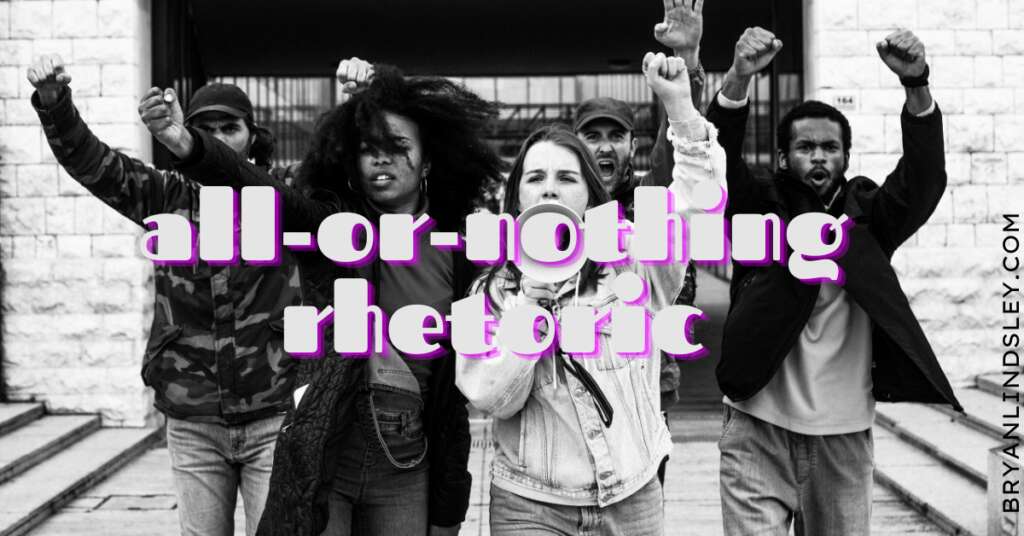This week’s tip: Avoid flawed narratives when creating and leading change initiatives
In order to convince people, you have to tell a compelling story, right?
Like choosing a narrative that tugs at the heartstrings.
Or using a touching anecdote that gets to the human story behind the data.
Choosing the best language to persuade others is paramount to influencing change in the long-run.
But rhetoric can also backfire.
Just turn on the daily news to what happens when urban legends, hyperbole, ideology, and anger are mixed together with catchy slogans.
People actually start to believe they know the truth, the whole truth, and nothing but the truth.
The result is that rhetoric itself begins to impede progress and increase extremism.
Nobody wins in that scenario.
In today’s issue, I share 6 common narratives that hinder productive discussion and effective action.
And then I share 2 ways to move beyond this kind of all-or-nothing rhetoric.
Escaping intolerance sold by rhetoric
The catalog of narratives I’ll share today was created by Albert O. Hirschman, a man with first-hand knowledge of intolerance sold by rhetoric.
As a young Jew he fled Nazi Germany.
He fought against Franco’s fascists in the Spanish Civil War. Then he worked in the French resistance. Finally, he did a tour of duty with the U.S. Army’s O.S.S. in northern Africa.
After the war he became an economist and worked at the Federal Reserve, Yale, Colombia, Harvard and Princeton.
But despite his credentials and lofty positions, Hirschman was always an outsider to power.
He was consistently on the side of the underdog, especially in Latin America where he focused on international development and community problem-solving (or lack thereof).
Over the course of his career, he noticed how frequently narratives about change actually served to prevent the desired change from occurring.
Rather than facilitate dialogue, they cut off debate.
Further, Hirschman believed that reactionary and progressive narratives are particularly dangerous because they promote a narrow view of history and limit the options for change.
Let’s examine them…
Reactionary narratives
#1. The perversity narrative
“Your solution will only make the problem worse!”
Basically, any attempt at social change will have the opposite effect and lead to more harm than good.
#2. The futility narrative
“Your solution will fail to make a dent!”
In general, social change is impossible and any attempts at reform will be ineffective.
#3. The jeopardy narrative
“The cost of your solution is too high and risks losing what we’ve already achieved!”
Essentially, any attempt at social change will result in the loss of cherished values and traditions.
These platitudes – false as they often are – can shut down the most compelling reformers and social movements.
And it’s easy for some changemakers to think that reactionary narratives are the main threat to social justice and social change.
But progressive narratives can be just as insidious.
Progressive narratives
#1. The synergy illusion
“All of our solutions can be simultaneously pursued and achieved.”
Essentially, all reforms work together and reinforce each other, rather than being competing.
#2. The imminent danger narrative
“We must act now!”
Specifically, urgent action is necessary to avoid imminent danger.
#3. History is on our side narrative
For example,
“The arc of history is long, but it bends towards justice.”
-Martin Luther King Jr.
In general, this is the idea that the future is predetermined or predestined to move in a certain direction, or that God is on our side.
The mature position
So, how can we avoid the dangers of reactionary and progressive narratives and engage in more productive discussions about social change?
Hirschman suggests that we adopt “mature bases” for discussion, specifically skepticism and pragmatism.
Here’s the mindset he recommends:
“There are dangers and risks in both action and inaction. The risks of both should be canvassed, assessed, and guarded against to the extent possible.”
And,
“The baneful consequences of either action or inaction can never be known with certainty, but our reaction to either is affected by the two types of alarm-sounding Cassandras with whom we have become acquainted.”
“When it comes to forecasts of impending mishaps or disasters, it is well to remember the saying Le pire n’est pas toujours sûr—the worst is not always sure (to happen).”
To recap:
While reactionary and progressive narratives may be tempting to persuade others, they can limit our ability to find effective solutions.
Instead, we should always apply a healthy dose of skepticism and pragmatism to rhetorical claims, especially our own.
==
See you again next week.
Whenever you’re ready, there are two ways I can help you:
→ I’m a strategic advisor for the toughest societal problems like poverty, crime and homelessness. People come to me when they want to stop spinning their wheels and get transformative, systems-level change.
→ I’m a coach for emerging and executive leaders in the social and public sectors who want to make progress on their biggest goals and challenges.
Let’s find out how I can help you become transformational.



